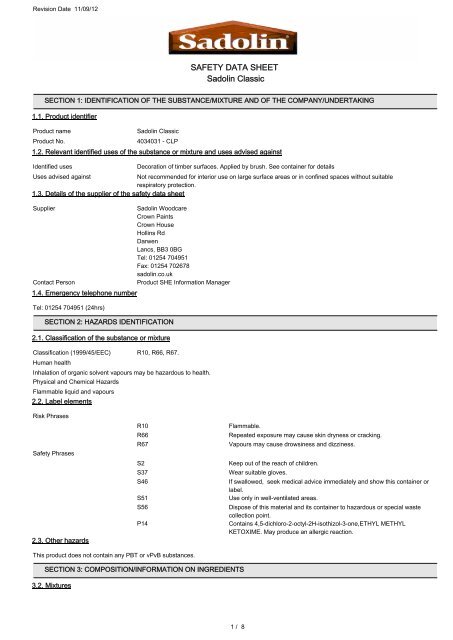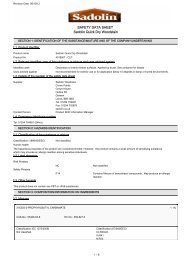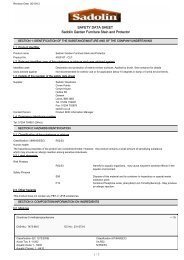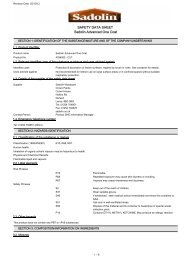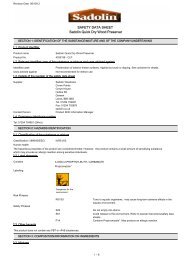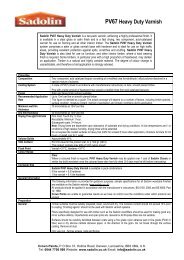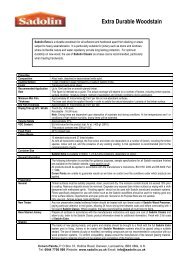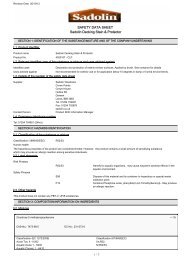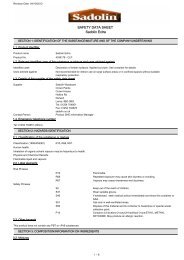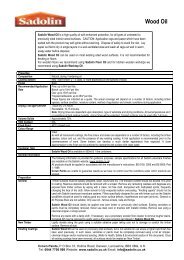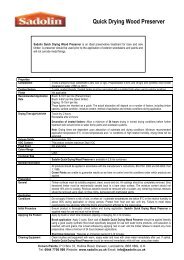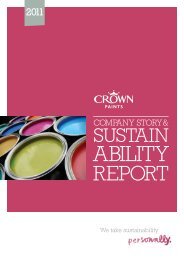SAFETY DATA SHEET Sadolin Classic
SAFETY DATA SHEET Sadolin Classic
SAFETY DATA SHEET Sadolin Classic
You also want an ePaper? Increase the reach of your titles
YUMPU automatically turns print PDFs into web optimized ePapers that Google loves.
Revision Date 11/09/12<br />
<strong>SAFETY</strong> <strong>DATA</strong> <strong>SHEET</strong><br />
<strong>Sadolin</strong> <strong>Classic</strong><br />
SECTION 1: IDENTIFICATION OF THE SUBSTANCE/MIXTURE AND OF THE COMPANY/UNDERTAKING<br />
1.1. Product identifier<br />
Product name<br />
Product No.<br />
<strong>Sadolin</strong> <strong>Classic</strong><br />
4034031 - CLP<br />
1.2. Relevant identified uses of the substance or mixture and uses advised against<br />
Identified uses<br />
Decoration of timber surfaces. Applied by brush. See container for details<br />
Uses advised against<br />
Not recommended for interior use on large surface areas or in confined spaces without suitable<br />
respiratory protection.<br />
1.3. Details of the supplier of the safety data sheet<br />
Supplier<br />
Contact Person<br />
1.4. Emergency telephone number<br />
Tel: 01254 704951 (24hrs)<br />
SECTION 2: HAZARDS IDENTIFICATION<br />
2.1. Classification of the substance or mixture<br />
Classification (1999/45/EEC) R10, R66, R67.<br />
Human health<br />
<strong>Sadolin</strong> Woodcare<br />
Crown Paints<br />
Crown House<br />
Hollins Rd<br />
Darwen<br />
Lancs, BB3 0BG<br />
Tel: 01254 704951<br />
Fax: 01254 702678<br />
sadolin.co.uk<br />
Product SHE Information Manager<br />
Inhalation of organic solvent vapours may be hazardous to health.<br />
Physical and Chemical Hazards<br />
Flammable liquid and vapours<br />
2.2. Label elements<br />
Risk Phrases<br />
Safety Phrases<br />
2.3. Other hazards<br />
R10<br />
R66<br />
R67<br />
S2<br />
S37<br />
S46<br />
S51<br />
S56<br />
P14<br />
Flammable.<br />
Repeated exposure may cause skin dryness or cracking.<br />
Vapours may cause drowsiness and dizziness.<br />
Keep out of the reach of children.<br />
Wear suitable gloves.<br />
If swallowed, seek medical advice immediately and show this container or<br />
label.<br />
Use only in well-ventilated areas.<br />
Dispose of this material and its container to hazardous or special waste<br />
collection point.<br />
Contains 4,5-dichloro-2-octyl-2H-isothizol-3-one,ETHYL METHYL<br />
KETOXIME. May produce an allergic reaction.<br />
This product does not contain any PBT or vPvB substances.<br />
SECTION 3: COMPOSITION/INFORMATION ON INGREDIENTS<br />
3.2. Mixtures<br />
1 / 8
<strong>Sadolin</strong> <strong>Classic</strong><br />
4,5-dichloro-2-octyl-2H-isothizol-3-one < 1%<br />
CAS-No.: 64359-81-5<br />
EC No.:<br />
Classification (EC 1272/2008)<br />
Skin Corr. 1B - H314<br />
Skin Sens. 1 - H317<br />
Aquatic Acute 1 - H400<br />
Classification (67/548/EEC)<br />
C;R34.<br />
N;R50.<br />
R43.<br />
ETHYL METHYL KETOXIME < 1%<br />
CAS-No.: 96-29-7 EC No.: 202-496-6<br />
Classification (EC 1272/2008)<br />
Acute Tox. 4 - H312<br />
Eye Dam. 1 - H318<br />
Skin Sens. 1 - H317<br />
Carc. 2 - H351<br />
Classification (67/548/EEC)<br />
Carc. Cat. 3;R40<br />
Xn;R21<br />
R43<br />
Xi;R41<br />
Naptha (petroleum), hydrotreated heavy - D40 Dearomatised 30-60%<br />
CAS-No.: 64742-48-9 EC No.: 265-150-3<br />
Classification (EC 1272/2008)<br />
Flam. Liq. 3 - H226<br />
EUH066<br />
STOT SE 3 - H336<br />
Asp. Tox. 1 - H304<br />
Classification (67/548/EEC)<br />
Xn;R65.<br />
R10,R66,R67.<br />
Naptha (petroleum), hydrotreated heavy - D60 High Flash 1-5%<br />
CAS-No.: 64742-48-9<br />
EC No.:<br />
Classification (EC 1272/2008)<br />
EUH066<br />
STOT SE 3 - H336<br />
Asp. Tox. 1 - H304<br />
Classification (67/548/EEC)<br />
Xn;R65.<br />
R66,R67.<br />
XYLENE < 1%<br />
CAS-No.: 1330-20-7 EC No.: 215-535-7<br />
Classification (EC 1272/2008)<br />
Flam. Liq. 3 - H226<br />
Acute Tox. 4 - H312<br />
Acute Tox. 4 - H332<br />
Skin Irrit. 2 - H315<br />
Classification (67/548/EEC)<br />
R10<br />
Xn;R20/21<br />
Xi;R38<br />
The Full Text for all R-Phrases and Hazard Statements are Displayed in Section 16.<br />
Composition Comments<br />
The product contains organic solvents. Petroleum substances contained in this product contain less than 0.1% w/w benzene.<br />
SECTION 4: FIRST AID MEASURES<br />
4.1. Description of first aid measures<br />
General information<br />
In all cases of doubt, or when symptoms persist, seek medical attention. Never give anything by mouth to an unconscious person.<br />
2 / 8
Inhalation<br />
<strong>Sadolin</strong> <strong>Classic</strong><br />
Remove to fresh air, keep the patient warm and at rest. If breathing has stopped, administer artificial respiration. Give nothing by mouth. If<br />
unconscious, place in a prone position with head to the side (recovery position) and seek medical advice.<br />
Ingestion<br />
If accidentally swallowed obtain immediate medical advice. Show this safety data sheet. Keep at rest. Do not induce vomiting. If conscious<br />
give milk or water to drink.<br />
Skin contact<br />
Remove contaminated clothing. Wash skin thoroughly with soap and water or use a proprietary skin cleaner. Do not use solvents or<br />
thinners.<br />
Eye contact<br />
Contact lenses should be removed. Irrigate copiously with clean, fresh water for at least 10 minutes, holding the eyelids apart, and seek<br />
medical advice.<br />
4.2. Most important symptoms and effects, both acute and delayed<br />
General information<br />
The severity of the symptoms described will vary dependant of the concentration and the length of exposure.<br />
Inhalation.<br />
Vapours may cause headache, fatigue, dizziness and nausea.<br />
Ingestion<br />
May cause discomfort if swallowed. Nausea, vomiting. Diarrhoea.<br />
Skin contact<br />
Prolonged contact may cause redness, irritation and dry skin.<br />
Eye contact<br />
Irritation of eyes and mucous membranes.<br />
4.3. Indication of any immediate medical attention and special treatment needed<br />
Consult safety data sheet.<br />
SECTION 5: FIREFIGHTING MEASURES<br />
5.1. Extinguishing media<br />
Extinguishing media<br />
Extinguish with alcohol-resistant foam, carbon dioxide, dry powder or water fog.<br />
Unsuitable extinguishing media<br />
Do not use water jet as an extinguisher, as this will spread the fire.<br />
5.2. Special hazards arising from the substance or mixture<br />
Hazardous combustion products<br />
Thermal decomposition or combustion may liberate carbon oxides and other toxic gases or vapours.<br />
Unusual Fire & Explosion Hazards<br />
No unusual fire or explosion hazards noted.<br />
Specific hazards<br />
Fire creates: Toxic gases/vapours/fumes of: Carbon monoxide (CO). Carbon dioxide (CO2). Nitrous gases (NOx).<br />
5.3. Advice for firefighters<br />
Special Fire Fighting Procedures<br />
Keep up-wind to avoid fumes. Cool containers exposed to flames with water until well after the fire is out. Keep run-off water out of sewers<br />
and water sources. Dike for water control.<br />
Protective equipment for fire-fighters<br />
Self contained breathing apparatus and full protective clothing must be worn in case of fire.<br />
SECTION 6: ACCIDENTAL RELEASE MEASURES<br />
6.1. Personal precautions, protective equipment and emergency procedures<br />
Wear protective clothing as described in Section 8 of this safety data sheet. Ensure suitable personal protection (including respiratory<br />
protection) during removal of spillages in a confined area. Take precautionary measures against static discharges. Do not smoke, use<br />
open fire or other sources of ignition. Do not breathe vapour. Eye contact MUST be prevented by means of suitable personal protection<br />
equipment.<br />
6.2. Environmental precautions<br />
Do not discharge onto the ground or into water courses. Do not allow ANY environmental contamination. Spillages or uncontrolled<br />
discharges into watercourses must be IMMEDIATELY alerted to the Environmental Agency or other appropriate regulatory body.<br />
6.3. Methods and material for containment and cleaning up<br />
If leakage cannot be stopped, evacuate area. Clean-up personnel should use respiratory and/or liquid contact protection. Wash<br />
thoroughly after dealing with a spillage. Extinguish all ignition sources. Avoid sparks, flames, heat and smoking. Ventilate. Absorb spillage<br />
with non-combustible, absorbent material. Transfer to a container for disposal. Flush area with plenty of water.<br />
3 / 8
6.4. Reference to other sections<br />
<strong>Sadolin</strong> <strong>Classic</strong><br />
For personal protection, see section 8. For waste disposal, see section 13.<br />
SECTION 7: HANDLING AND STORAGE<br />
7.1. Precautions for safe handling<br />
Keep away from heat, sparks and open flame. Eliminate all sources of ignition. Avoid contact with skin and eyes. Static electricity and<br />
formation of sparks must be prevented. Good personal hygiene is necessary. Wash hands and contaminated areas with water and soap<br />
before leaving the work site. Do not eat, drink or smoke when using the product. Observe good chemical hygiene practices. Do not use in<br />
confined spaces without adequate ventilation and/or respirator. Provide good ventilation. Container must be kept tightly closed.<br />
7.2. Conditions for safe storage, including any incompatibilities<br />
Keep away from heat, sparks and open flame. Keep containers tightly closed. Keep away from food, drink and animal feeding stuffs.<br />
Flammable/combustible - Keep away from oxidisers, heat and flames. Keep in original container. Store away from: Acids. Alkalis.<br />
Storage Class<br />
The storage of this product is not subject to any statutory requirements.<br />
7.3. Specific end use(s)<br />
Usage Description<br />
Use product only in accordance with methods listed in section 1.<br />
SECTION 8: EXPOSURE CONTROLS/PERSONAL PROTECTION<br />
8.1. Control parameters<br />
Name<br />
STD<br />
TWA - 8 Hrs<br />
STEL - 15 Min<br />
Notes<br />
Naptha (petroleum), hydrotreated heavy - D40<br />
Dearomatised<br />
Naptha (petroleum), hydrotreated heavy - D60 High<br />
Flash<br />
XYLENE<br />
WEL 197 ppm 1200 mg/m3 No std. No std.<br />
WEL 197 No std. 1200 No std. ppm mg/m3<br />
WEL 50 ppm(Sk) 220<br />
100<br />
mg/m3(Sk) ppm(Sk)<br />
441<br />
mg/m3(Sk)<br />
WEL = Workplace Exposure Limit.<br />
Ingredient Comments<br />
LT = Long term exposure limit. ST = Short term exposure limit. TWA = Time weighted average. Ppm = Parts per million Mgm-3 = Milligrams<br />
per cubic metre. Sk = Indicates a risk of absorption through skin.<br />
8.2. Exposure controls<br />
Protective equipment<br />
Process conditions<br />
Provide eyewash, quick drench.<br />
Engineering measures<br />
Provide adequate ventilation, including appropriate local extraction, to ensure that the defined occupational exposure limit is not<br />
exceeded.<br />
Respiratory equipment<br />
If ventilation is insufficient, suitable respiratory protection must be provided. At work in confined or poorly ventilated spaces, respiratory<br />
protection with air supply must be used. Check that mask fits tight and change filter regularly.<br />
Hand protection<br />
Protective gloves must be used if there is a risk of direct contact or splash. Gloves of nitrile rubber, PVA or Viton are recommended.<br />
Eye protection<br />
Wear approved chemical safety goggles where eye exposure is reasonably probable.<br />
Other Protection<br />
Wear appropriate clothing to prevent any possibility of skin contact. Provide eyewash station.<br />
Hygiene measures<br />
Wash hands at the end of each work shift and before eating, smoking and using the toilet.<br />
Skin protection<br />
Wear apron or protective clothing in case of splashes.<br />
4 / 8
Environmental Exposure Controls<br />
See section 12.<br />
<strong>Sadolin</strong> <strong>Classic</strong><br />
SECTION 9: PHYSICAL AND CHEMICAL PROPERTIES<br />
9.1. Information on basic physical and chemical properties<br />
Appearance<br />
Liquid<br />
Colour<br />
Range of colours<br />
Odour<br />
Characteristic.<br />
Solubility<br />
Immiscible with water<br />
Initial boiling point and boiling range 149 - 213<br />
Bulk Density<br />
0.903 kg/l<br />
Vapour density (air=1) >1<br />
Vapour pressure 0.05 kPa 20°C<br />
Viscosity 42 s @ 21 °C<br />
B4 Flow cup<br />
Flash point<br />
38 Sh CC (Setaflash closed cup).<br />
Auto Ignition Temperature (°C) 230 - 270<br />
Flammability Limit - Lower(%) 0.6<br />
Flammability Limit - Upper(%) 6<br />
9.2. Other information<br />
SECTION 10: STABILITY AND REACTIVITY<br />
10.1. Reactivity<br />
There are no known reactivity hazards associated with this product.<br />
10.2. Chemical stability<br />
Stable under normal temperature conditions and recommended use.<br />
10.3. Possibility of hazardous reactions<br />
Not determined.<br />
10.4. Conditions to avoid<br />
Protect from frost, heat and sunlight.<br />
10.5. Incompatible materials<br />
Materials To Avoid<br />
Strong oxidising substances. Strong acids. Strong alkalis.<br />
10.6. Hazardous decomposition products<br />
None at ambient temperatures. Thermal decomposition or combustion may liberate carbon oxides and other toxic gases or vapours.<br />
SECTION 11: TOXICOLOGICAL INFORMATION<br />
11.1. Information on toxicological effects<br />
General information<br />
Contains small amounts of organic solvents. Extensive use of the product in areas with inadequate ventilation may result in hazardous<br />
vapour concentrations.<br />
Inhalation<br />
When working extensively on big surfaces in small and badly ventilated rooms, vapours may develop in concentrations which may cause<br />
malaise such as headache, dizziness and nausea.<br />
Ingestion<br />
Nausea, vomiting. Headache. Diarrhoea.<br />
Skin contact<br />
May cause defatting of the skin, but is not an irritant. Repeated exposure may cause skin dryness or cracking. The product contains a<br />
small amount of sensitising substance which may provoke an allergic reaction among sensitive individuals after repeated contact.<br />
Eye contact<br />
May cause temporary eye irritation.<br />
5 / 8
<strong>Sadolin</strong> <strong>Classic</strong><br />
SECTION 12: ECOLOGICAL INFORMATION<br />
Ecotoxicity<br />
There are no data on the ecotoxicity of this product. The product is not expected to be hazardous to the environment. The product contains<br />
substances which are toxic to aquatic organisms and which may cause long term adverse effects in the aquatic environment.<br />
12.1. Toxicity<br />
Do not allow to enter drains, sewers or watercourses.<br />
12.2. Persistence and degradability<br />
The product is not expected to be biodegradable.<br />
12.3. Bioaccumulative potential<br />
Bioaccumulative potential<br />
Bioaccumulation is unlikely to be significant because of the low water solubility of this product.<br />
12.4. Mobility in soil<br />
Mobility:<br />
Not considered mobile.<br />
12.5. Results of PBT and vPvB assessment<br />
This product does not contain any PBT or vPvB substances.<br />
12.6. Other adverse effects<br />
Not determined.<br />
SECTION 13: DISPOSAL CONSIDERATIONS<br />
General information<br />
When this product, in its liquid state, as supplied or skinned, becomes a waste, it is categorised as hazardous waste, with code 08 01 11<br />
(list of wastes). Part used containers, not drained and/ or rigorously scraped out and containing dried residues of the supplied product, are<br />
categorised as non-hazardous waste, with code 08 01 12 (list of wastes). Used containers, drained and/ or rigorously scraped out and<br />
containing dried residues of the supplied product, are categorised as non-hazardous waste, with code 15 01 02 or 15 01 04 (list of<br />
wastes). If mixed with other wastes, the above waste code may not be applicable.<br />
13.1. Waste treatment methods<br />
Do not allow runoff to sewer, waterway or ground. Dispose of waste and residues in accordance with local authority requirements.<br />
Waste Class<br />
Waste product 08 01 11 Used packaging containg only dried residues 15 01 02<br />
SECTION 14: TRANSPORT INFORMATION<br />
General<br />
14.1. UN number<br />
The product is not covered by international regulation on the transport of dangerous goods (IMDG, IATA,<br />
ADR/RID).<br />
UN No. (ADR/RID/ADN) 1263<br />
14.2. UN proper shipping name<br />
14.3. Transport hazard class(es)<br />
ADR/RID/ADN Class<br />
Class 3: Flammable liquids.<br />
Transport Labels<br />
No transport warning sign required.<br />
14.4. Packing group<br />
14.5. Environmental hazards<br />
Environmentally Hazardous Substance/Marine Pollutant<br />
No.<br />
6 / 8
14.6. Special precautions for user<br />
<strong>Sadolin</strong> <strong>Classic</strong><br />
Tunnel Restriction Code<br />
(D/E)<br />
14.7. Transport in bulk according to Annex II of MARPOL73/78 and the IBC Code<br />
Not applicable.<br />
SECTION 15: REGULATORY INFORMATION<br />
15.1. Safety, health and environmental regulations/legislation specific for the substance or mixture<br />
Uk Regulatory References<br />
The products are classified and supplied in accordance with the Chemicals (Hazard Information Packaging for supply) regulations (CHIP).<br />
The information contained in this safety data sheet does not constitute the user's own assessment of workplace risks as required by other<br />
health and safety legislation. The provision of the Health and Safety at Work Act and the Control of Substances Hazardous to Health<br />
regulations apply to the use of this product at work.<br />
Approved Code Of Practice<br />
Approved classification and labelling guide (Sixth edition) The compilation of safety data sheets (Third edition)<br />
Guidance Notes<br />
Workplace Exposure Limits EH40. Storage of Flammable Liquids in Containers, HS(G)51 Storage of Packaged Dangerous Substances,<br />
HS(G)71<br />
EU Legislation<br />
Dangerous Substance Directive 67/548/EEC. Dangerous Preparations Directive 1999/45/EC. Regulation (EC) No 1907/2006 of the<br />
European Parliament and of the Council of 18 December 2006 concerning the Registration, Evaluation, Authorisation and Restriction of<br />
Chemicals (REACH), establishing a European Chemicals Agency, amending Directive 1999/45/EC and repealing Council Regulation<br />
(EEC) No 793/93 and Commission Regulation (EC) No 1488/94 as well as Council Directive 76/769/EEC and Commission Directives<br />
91/155/EEC, 93/67/EEC, 93/105/EC and 2000/21/EC, including amendments. Classification, labelling and packaging of substances and<br />
mixtures 1272/2008EC<br />
National Regulations<br />
The Control Of Substances Hazardous to Health regulations (as amended) The Manual Handling Operations regulations (as amended) The<br />
Environmental Protection (Duty of Care) regulations (as amended) The Chemicals (Hazard Information and Packaging) for supply<br />
regulations (as amended) The Health and Safety at Work act 1974 (as amended)<br />
15.2. Chemical Safety Assessment<br />
No chemical safety assessment has been carried out.<br />
SECTION 16: OTHER INFORMATION<br />
General information<br />
The information contained in this safety data sheet is provided in accordance with the requirements of the regulations. The product should<br />
not be used for purposes other than those shown in section 1 without first referring to the supplier and obtaining written handling instruction.<br />
As the specific conditions of use of the product are outside the suppliers control, the user is responsible for ensuring that the requirements<br />
of relevant legislation are complied with.<br />
Revision Comments<br />
This information is provided in a revised format to that previously produced.<br />
Issued By<br />
Revision Date 11/09/12<br />
SDS No. Revision 7<br />
Risk Phrases In Full<br />
R34<br />
R10<br />
R20/21<br />
R21<br />
R65<br />
R38<br />
R40<br />
R43<br />
R66<br />
R41<br />
R67<br />
R50<br />
Causes burns.<br />
Flammable.<br />
Product SHE Information Manager<br />
Harmful by inhalation and in contact with skin.<br />
Harmful in contact with skin.<br />
Harmful: may cause lung damage if swallowed.<br />
Irritating to skin.<br />
Limited evidence of a carcinogenic effect.<br />
May cause sensitisation by skin contact.<br />
Repeated exposure may cause skin dryness or cracking.<br />
Risk of serious damage to eyes.<br />
Vapours may cause drowsiness and dizziness.<br />
Very toxic to aquatic organisms.<br />
7 / 8
Hazard Statements In Full<br />
EUH066<br />
H226<br />
H304<br />
H312<br />
H314<br />
H315<br />
H317<br />
H318<br />
H332<br />
H336<br />
H351<br />
H400<br />
<strong>Sadolin</strong> <strong>Classic</strong><br />
Repeated exposure may cause skin dryness or cracking.<br />
Flammable liquid and vapour.<br />
May be fatal if swallowed and enters airways.<br />
Harmful in contact with skin.<br />
Causes severe skin burns and eye damage.<br />
Causes skin irritation.<br />
May cause an allergic skin reaction.<br />
Causes serious eye damage.<br />
Harmful if inhaled.<br />
May cause drowsiness or dizziness.<br />
Suspected of causing cancer.<br />
Very toxic to aquatic life.<br />
Disclaimer<br />
The information provided in this safety data sheet is based on the present state of knowledge and current national legislation. It provides guidance on<br />
health and safety and environmental aspects and should not be construed as any guarantee of technical performance or suitablility for particular<br />
applications.<br />
8 / 8


